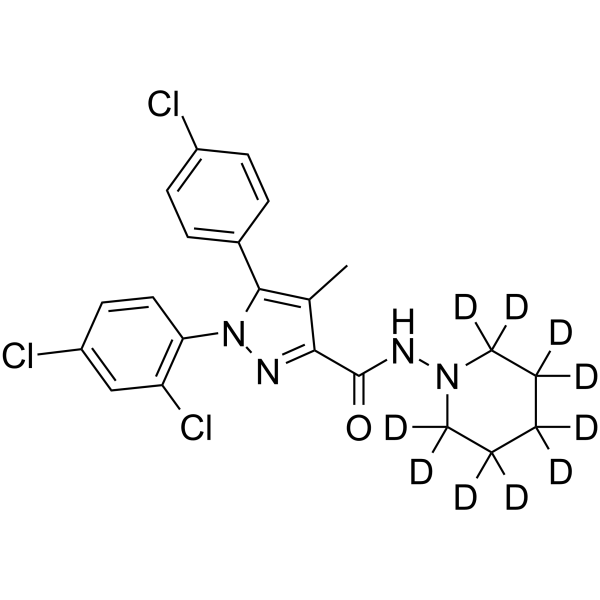Rimonabant-d10
Modify Date: 2025-08-25 20:56:16

Rimonabant-d10 structure
|
Common Name | Rimonabant-d10 | ||
|---|---|---|---|---|
| CAS Number | 929221-88-5 | Molecular Weight | 473.85 | |
| Density | N/A | Boiling Point | N/A | |
| Molecular Formula | C22H11D10Cl3N4O | Melting Point | N/A | |
| MSDS | N/A | Flash Point | N/A | |
Use of Rimonabant-d10Rimonabant-d10 is deuterium labeled Rimonabant. Rimonabant (SR141716) is a highly potent, brain penetrated and selective central cannabinoid receptor (CB1) antagonist with a Ki of 1.8 nM. Rimonabant (SR141716) also inhibits Mycobacterial membrane protein Large 3 (MMPL3). |
| Name | 1H-Pyrazole-3-carboxamide, 5-(4-chlorophenyl)-1-(2,4-dichlorophenyl)-4-methyl-N-(1-piperidinyl-2,2,3,3,4,4,5,5,6,6-d10) |
|---|---|
| Synonym | More Synonyms |
| Description | Rimonabant-d10 is deuterium labeled Rimonabant. Rimonabant (SR141716) is a highly potent, brain penetrated and selective central cannabinoid receptor (CB1) antagonist with a Ki of 1.8 nM. Rimonabant (SR141716) also inhibits Mycobacterial membrane protein Large 3 (MMPL3). |
|---|---|
| Related Catalog | |
| In Vitro | Stable heavy isotopes of hydrogen, carbon, and other elements have been incorporated into drug molecules, largely as tracers for quantitation during the drug development process. Deuteration has gained attention because of its potential to affect the pharmacokinetic and metabolic profiles of drugs[1]. |
| References |
| Molecular Formula | C22H11D10Cl3N4O |
|---|---|
| Molecular Weight | 473.85 |
| Exact Mass | 462.07800 |
| PSA | 50.16000 |
| LogP | 6.26740 |
| InChIKey | JZCPYUJPEARBJL-ODKVXHBQSA-N |
| SMILES | Cc1c(C(=O)NN2CCCCC2)nn(-c2ccc(Cl)cc2Cl)c1-c1ccc(Cl)cc1 |
| rimonabant-d10 |